A
Auto Express
Guest
When the Range Rover Evoque arrived in 2011, it was so impressive that it won our coveted Car of the Year award. It was even ranked as our Best Compact SUV the following year, and with over 500,000 produced within five years of its launch the Evoque was a huge success. With all this in mind, a used model could be a good choice, so read on to find out what to look for in this family SUV.
When the car was new we praised the ride and handling, its performance, the good level of equipment and the interior quality. We weren't so sure about the high price, poor fuel economy and limited practicality. Those things are still true of used models so be aware of those things before you consider one.
To give a little background on the Evoque, it was launched when Land Rover was looking to bring more customers into the fold who couldn't afford its more expensive Range Rover Sport model. The smaller and more affordable Evoque was the company's answer to this, and it brought the features of that car down to a lower price point. It was a capable off-roader but was focused on road-going buyers who wanted a stylish, comfortable cruiser that could fit the whole family inside and still impress the neighbours.
The Range Rover Evoque was launched in 2011 and was replaced by the second-generation model in 2018. The former is our focus here.

image
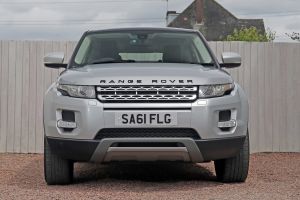
image
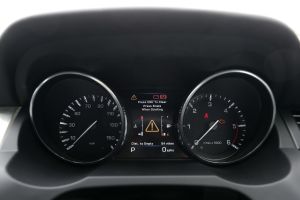
image
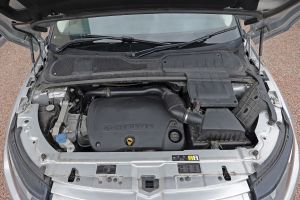
image
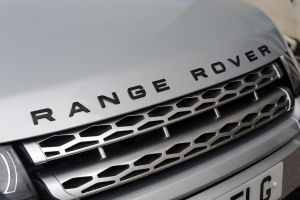
image
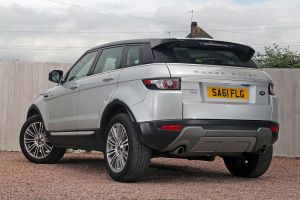
image
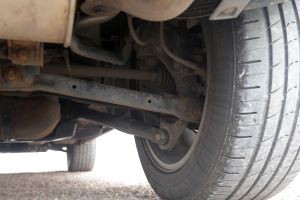
image
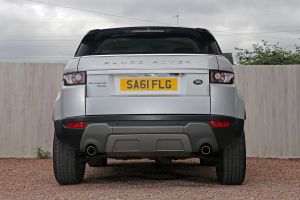
image
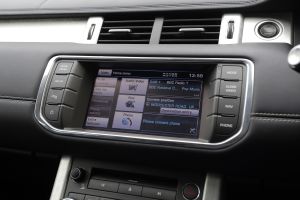
image
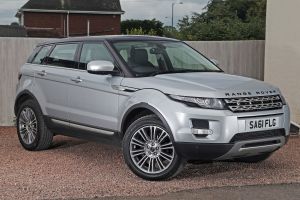
image

image
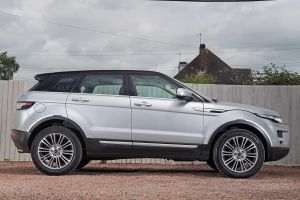
image

image
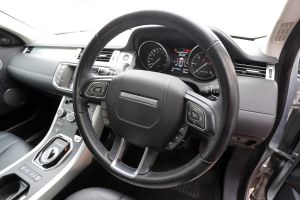
image
The Evoque was available in both three and five-door guises. From the outset there were 2.0-litre petrol or 2.2-litre diesel engines, the former as an auto only.
Diesel cars came in six-speed manual 150bhp form with front-wheel drive (eD4) or four-wheel drive (TD4); there was also a 190bhp SD4 with four-wheel drive and manual or automatic boxes. At first the auto was a six-speed unit, but from autumn 2013 it was replaced by a more efficient nine-speed box. A raft of new driver assistance tech made its debut at the same time.
A facelifted Evoque arrived in summer 2015 with more efficient engines, extra tech and safety features, plus a tweaked design. A convertible car followed in spring 2016.
There's not really a stand-out engine or transmission, although petrols are less fuel-efficient than diesel versions. The manual is okay, the auto suits the car well and the nine-speed version is the best. Front-wheel drive is fine for most but 4x4 gives it the Land Rover credentials that many want.

image

image

image

image

image

image

image

image

image

image

image

image

image

image
The entry-level Pure has cruise control, ESP and Trailer Stability Assist, along with eight-inch touchscreen multimedia, electric windows all round, rear parking sensors and ambient cabin illumination. Prestige spec adds leather trim and electric front seat adjustment to the package, while the Dynamic features a bodykit. The Dynamic Plus includes heated front sports seats.
The Tech Pack adds automatic lights and wipers, plus front parking sensors, while the Lux Pack brings a powered tailgate, glass roof, TV, park assist and climate control to the specification.
The Evoque has some talented rivals, such as the Audi Q5, which has efficient engines and lots of equipment, but is less distinctive inside and out than the baby Range Rover. All of this also applies to the BMW X3, which drives well and, as with the Audi, comes in five-door form only.
The Volvo XC60 of the same era was crammed with safety features, while comfort levels are a major plus, too. We’d also look at the Mazda CX-5, which is very good value for money, and could well prove more reliable than the Land Rover.
Many Evoques have a heated windscreen. But if you do a lot of night driving, lights from oncoming traffic can pick out the elements, causing a distraction.
All examples have leather trim, which can get very baggy very quickly, especially on the bases of the front seats. Check the driver’s seat first.
If the luggage bay is full the parcel shelf can rub on the boot surround, wearing away the finish on the latter. A repaint is then necessary to repair the damage.
Clonks from the front or rear suspension can be evident when the Evoque is going over bumps. So far, there’s no definitive solution to rectify the problem.

image

image

image

image

image

image

image

image

image

image

image

image

image

image
The Evoque is classy inside, with premium materials everywhere, but the multimedia touchscreen feels dated. The seats are comfortable and there’s plenty of room for two in the back. Boot space in the three-door is 550 litres with the seats up or 1,350 litres with them down; the five-door offers 575 and 1,445 litres.
See the latest used Range Rover Evoque prices on our sister site BuyaCar or use our free valuation tool to price a specific model.
Evoque services can be fixed (at 16,000 miles or 12 months) or variable (up to 24 months and 21,000 miles). Fixed check-ups alternate between minor (around £400) and major (around £520). The variable service costs about £450-£550, but the cambelt has to replaced at around 108,000 miles. Expect to pay £1,000 including a full service.
Fresh brake fluid is required every three years, at £58, while the coolant must be replaced every 10 years, at £150-£250. Since January 2013 Land Rover has offered a £499 pack, covering all routine servicing for the first five years or 60,000 miles; a 75,000-mile pack is £649. The packs can be transferred between owners.
There have been six recalls. The first was in December 2015 because engine harness chafing could lead to short circuits and the engine cutting out. The next came in August 2016 due to fuel leaks caused by chafing hoses.
Airbags failing to deploy led to another recall in December 2016. Electrical short circuits were behind campaigns in December 2016 and January 2017. Some cars were recalled in December 2016 because steering parts fitted incorrectly could cause a loss of control. There was also a recall in 2019 related to CO2 emissions.

image

image

image

image

image

image

image

image

image

image

image

image

image

image
A ranking of 55th in our Driver Power 2017 satisfaction survey was respectable, though the car didn't appear in the top 75 in the 2020 survey. The best it’s ever managed was 36th in 2014.
Continue reading...
When the car was new we praised the ride and handling, its performance, the good level of equipment and the interior quality. We weren't so sure about the high price, poor fuel economy and limited practicality. Those things are still true of used models so be aware of those things before you consider one.
- SEE MORE Best SUVs to buy 2020
To give a little background on the Evoque, it was launched when Land Rover was looking to bring more customers into the fold who couldn't afford its more expensive Range Rover Sport model. The smaller and more affordable Evoque was the company's answer to this, and it brought the features of that car down to a lower price point. It was a capable off-roader but was focused on road-going buyers who wanted a stylish, comfortable cruiser that could fit the whole family inside and still impress the neighbours.
The Range Rover Evoque was launched in 2011 and was replaced by the second-generation model in 2018. The former is our focus here.
Models covered
- • Range Rover Evoque Mk1 (2011-2018) - Sharply styled SUV was a popular introduction to premium brand.
Range Rover Evoque Mk1

image

image

image

image

image

image

image

image

image

image

image

image

image

image
History
The Evoque was available in both three and five-door guises. From the outset there were 2.0-litre petrol or 2.2-litre diesel engines, the former as an auto only.
Diesel cars came in six-speed manual 150bhp form with front-wheel drive (eD4) or four-wheel drive (TD4); there was also a 190bhp SD4 with four-wheel drive and manual or automatic boxes. At first the auto was a six-speed unit, but from autumn 2013 it was replaced by a more efficient nine-speed box. A raft of new driver assistance tech made its debut at the same time.
A facelifted Evoque arrived in summer 2015 with more efficient engines, extra tech and safety features, plus a tweaked design. A convertible car followed in spring 2016.
Range Rover Evoque reviews
- Range Rover Evoque in-depth review
- Range Rover Evoque SE Tech review
- Range Rover Evoque TD4 Prestige review
- Range Rover Evoque SD4 Prestige LUX review
- Range Rover Evoque eD4 2WD review
- Range Rover Evoque Special Edition review
- Range Rover Evoque long-term test review
Which one should I buy?
There's not really a stand-out engine or transmission, although petrols are less fuel-efficient than diesel versions. The manual is okay, the auto suits the car well and the nine-speed version is the best. Front-wheel drive is fine for most but 4x4 gives it the Land Rover credentials that many want.

image

image

image

image

image

image

image

image

image

image

image

image

image

image
The entry-level Pure has cruise control, ESP and Trailer Stability Assist, along with eight-inch touchscreen multimedia, electric windows all round, rear parking sensors and ambient cabin illumination. Prestige spec adds leather trim and electric front seat adjustment to the package, while the Dynamic features a bodykit. The Dynamic Plus includes heated front sports seats.
The Tech Pack adds automatic lights and wipers, plus front parking sensors, while the Lux Pack brings a powered tailgate, glass roof, TV, park assist and climate control to the specification.
Alternatives to the Range Rover Evoque
The Evoque has some talented rivals, such as the Audi Q5, which has efficient engines and lots of equipment, but is less distinctive inside and out than the baby Range Rover. All of this also applies to the BMW X3, which drives well and, as with the Audi, comes in five-door form only.
The Volvo XC60 of the same era was crammed with safety features, while comfort levels are a major plus, too. We’d also look at the Mazda CX-5, which is very good value for money, and could well prove more reliable than the Land Rover.
What to look for:
Windscreen
Many Evoques have a heated windscreen. But if you do a lot of night driving, lights from oncoming traffic can pick out the elements, causing a distraction.
Upholstery
All examples have leather trim, which can get very baggy very quickly, especially on the bases of the front seats. Check the driver’s seat first.
Parcel shelf
If the luggage bay is full the parcel shelf can rub on the boot surround, wearing away the finish on the latter. A repaint is then necessary to repair the damage.
Suspension
Clonks from the front or rear suspension can be evident when the Evoque is going over bumps. So far, there’s no definitive solution to rectify the problem.

image

image

image

image

image

image

image

image

image

image

image

image

image

image
Interior
The Evoque is classy inside, with premium materials everywhere, but the multimedia touchscreen feels dated. The seats are comfortable and there’s plenty of room for two in the back. Boot space in the three-door is 550 litres with the seats up or 1,350 litres with them down; the five-door offers 575 and 1,445 litres.
Prices
See the latest used Range Rover Evoque prices on our sister site BuyaCar or use our free valuation tool to price a specific model.
Running costs
Evoque services can be fixed (at 16,000 miles or 12 months) or variable (up to 24 months and 21,000 miles). Fixed check-ups alternate between minor (around £400) and major (around £520). The variable service costs about £450-£550, but the cambelt has to replaced at around 108,000 miles. Expect to pay £1,000 including a full service.
Fresh brake fluid is required every three years, at £58, while the coolant must be replaced every 10 years, at £150-£250. Since January 2013 Land Rover has offered a £499 pack, covering all routine servicing for the first five years or 60,000 miles; a 75,000-mile pack is £649. The packs can be transferred between owners.
Recalls
There have been six recalls. The first was in December 2015 because engine harness chafing could lead to short circuits and the engine cutting out. The next came in August 2016 due to fuel leaks caused by chafing hoses.
Airbags failing to deploy led to another recall in December 2016. Electrical short circuits were behind campaigns in December 2016 and January 2017. Some cars were recalled in December 2016 because steering parts fitted incorrectly could cause a loss of control. There was also a recall in 2019 related to CO2 emissions.

image

image

image

image

image

image

image

image

image

image

image

image

image

image
Driver Power owner satisfaction
A ranking of 55th in our Driver Power 2017 satisfaction survey was respectable, though the car didn't appear in the top 75 in the 2020 survey. The best it’s ever managed was 36th in 2014.
Continue reading...
